Today’s missive is a cheat, a grift, a dodge…
Which I feel pretty much fits the moment we are in.
I’ve been busy, which is good, so I’ve been negligent in my Substacking duties. (It’s why I don’t take money for doing this, I don’t want it to feel like a job, with God Forbid, obligations.) And I figure you can hear me bleating away nearly every week on the Hacks on Tap podcast, so it’s not exactly a Murphy opinion desert out there.
Still, I feel remiss. Been too long since I’ve posted.
So here is where the cheat comes in.
Today’s Substack blog is a clip show. That’s a term from old-school episodic television, referring to a series that, near the end of the season, finds itself short on production dollars, staff energy and especially time. So a skinny (and cheap, it is show business) episode is created in the clutch by taking clips from earlier episode and reusing them, often with a trick device like a character dream, to create a cheap to shoot Hamburger Helper sort of episode.
There is also the “ugh” factor. You know what I’m talking about dear Patriots.
So here goes. I’m attaching to clips from the last few weeks that I’ve written on other platforms.
First, here is an op-ed I wrote a few weeks ago for the Times. (No not that cheeky American upstart, the Sunday Times in the UK. I like to keep the Empire up to date on the political ‘aggro here among the Yanks.)
My views today are still the same as when I wrote this piece before our new Golden Age President was sworn in. I think he’s a clumsy, frantic shooter working under a fast-ticking shot clock and heading for certain political trouble, especially if he really wants to give his sclerotic tariff fantasy a big try. I also speculate on the whole DOGE caper, which I think will quickly hit the rocks due both to the bizarre structural reality of our Federal government and the “two tomcats caught inside one pillow sack” dynamic that I think will overcome the Elon n’ Donald bromance.
Also, I posted a grab bag of EV stuff yesterday on the EVPolitics.org blog.
Why do I spend so much time on this EV stuff (so far, I’ve volunteered all my time)?
First, happiness. I wrote about that in my first Substack post.
But most important, the very high stakes for America.
Let me show you in a single chart. (HT to China auto expert Michael Dunne.)
Yup that shrinking dark blue bar is US Auto production.
Why should we care? One simple set of facts:
In the mid-1930’s, total German car and truck production was around 355,000 units a year. Total British Empire car and truck production in the mid-30’s (before rearmament really started) was around 500,000 units.
In the U.S.A., total car and truck production in 1940, a year before Pearl Harbor, was 4.7 million units.
Manufacturing power is a very important aspect of national security. And China, waging a conquest strategy that is not about making profits but instead about dominating world automotive production, is well on track to supremacy.
We have a lot of interesting post-election polling data coming soon on this whole EV and automotive topic soon; what Americans think about China as an auto competitor, about trade and traffics, NatSec risks of PRC-connected car electronics (and the Raimondo ban!)
We’ll miss ya Gina! (China won’t.)
Plus a lot more… especially about the silly partisan divide over EVs that is playing so perfectly into China’s hands.
So… here is a clump of things from hot off our EVPolitics blog, written by yours truly with a huge assist from our Exec Director Joe Sacks. In it I talk about Trump’s noisy executive order declaring war on EVs (with a few political observations about where all those new 200,000 American EV manufacturing jobs that he’d like to erase actually are. Hint: 28 GOP Congressional districts).
I also opine on Tesla’s Cybertruck sales fail (Sorry Elon), and offer up a bit of well-earned applause for Ford’s effective new fix for the home charging installation worries many first-time EV buyers face.
So, that’s our clip show! Not too bad, right? Until next time, enjoy!
From the EVPolitics.org Blog:
By Mike Murphy
2025 looks like a watershed year for EVs in the U.S. and around the world. A few thoughts…
Let’s start with Washington DC.
We have a new President and the fight over subsidies left from the Biden administration will be big. On one hand President-elect Trump has been bashing EV subsidies for a year. As part of his Day One Executive Order-a-thon, he signed an EO full of anti-EV rhetoric – particularly a blast at “EV Mandates” (which do not actually exist) – which targets EPA mileage standards (which will likely loosen) and ending California’s clean air waiver (that’ll go to the courts.). The EO also included a murky demand for the Feds to somehow stop disbursing NEVI and other infrastructure funding which is already committed and pouring into the states.
But now that the campaign is over the hard realities of DC politics will replace easy campaign trail rhetoric. Here are a few of the tough choices the new President will have to make:
Declare war on consumer focus EV subsidies. Easy to say, hard to do. Big changes will require Congressional action. That won’t happen fast, especially in a House with a shaky three seat margin.
Trump could have the IRS go after the so-called EV lease loophole (worth $7500 bucks off your cost if you lease an EV). Since that is an IRS policy driven item, he could probably do it fast and without Congressional help. But…
Try to screw with the billions in loans that have already been committed toward new EV manufacturing plants across the U.S. Like Hyundai’s huge new mega plant in Georgia, the largest such project in state history, Ford’s massive new Blue Oval facility in Tennessee, now under construction. Or Rivian’s big new plant in George with more than 8,000 new jobs. The list of these plants is long and job count is massive.
Will Trump actually do it? Can he?
It’s a mixed bag but have no doubt Trump can indeed put a mighty whack on the consumer subsidies, as he’s threatened.
But slashing consumer EV subsidies or trying to reverse new plant construction would have a big, painful political cost.
When Germany cut its consumer EV subsidies, sales dropped 27%. Ouch; that means auto plant layoffs in America is there is a big EV sales drop here. (75% of the EVs sold in America are made in America.)
If you take the $312 billion of investment in American EV related manufacturing and rank that spending by Congressional District, 28 of those Districts are held by Republicans. Only 7 by Democrats. (A fact we at the American EV Jobs Alliance plan to make famous in those GOP Districts. Stay tuned.). I doubt the Trump administration, which ran on “fixing” the economy, wants to see big layoffs at U.S. EV plants if sales collapse. And if Trump goes after the loan program for building new plants, all it takes is for a handful of GOP Members from huge EV investment Districts to say no and Congressional action will grind to a halt.
I think it’s possible the Trump administration will figure out how tricky and painful all this is – as well as a potential long term National Security disaster – and decide to just declare victory with a few subsidy tweaks and move away from killing U.S. manufacturing jobs and focus instead on loosening EPA mileage standards as well as waging a noisy war with California’s Democrats over their state’s clean air waiver and potential future ICE vehicle restrictions. We’ll see.
***
It is going to be a tough year in the automotive business… in China. While the conventional wisdom – China now has the world’s biggest automotive industry and is going to wipe out competition across the world over the next 5 to 10 years — is basically correct, the story is getting far more complicated.
The Chinese government has had a conquest strategy for cars, both gasoline powered and EV. Massive subsidies have created dozens of new car companies, most of which lose money. But a political conquest strategy isn’t about profits, it’s about eating foreign markets for political power reasons. So far, the Chinese plan has worked, at least from a market share point of view. Take Mexico. Four years ago China exported roughly 40,000 cars to Mexico. In 2024 China sold over 400,000 cars there’s a 10x increase in just 48 months.
Many of my fellow free-marketeers will now say, that’s fine, it’s competition and competition is good. But it’s hard to compete when the conquest driven brand doesn’t care about making any money? That’s why the looming global China car invasion (already afoot in Latin America, Israel, Australia, Thailand and now beginning in Europe) is not analogous to the Japan car invasion of U.S. markets in the late 70’s. It’s not about fair competition.
But now, there are signs the Chinese strategy may be evolving. After all this investment, China has built a huge overcapacity in auto manufacturing. Only a very few of China’s 130 plus automakers are profitable. With a raging price war at home and massing losses mounting from this overcapacity, it is likely many Chinese car companies will go out of business this year.
(Sidebar: why is overcapacity so deadly in the auto business? Generally, auto plants must run at about 75 to 80% capacity to be break even or slightly profitable. If Chang Murphy Automotive’s beautiful new plant is only running at 50% capacity, I’m losing lots of cash and if the Government stops funding me, it’s soon over.)
Since China cannot, now, dump its cars in the profitable U.S. market due to high tariffs and national security restrictions on Chinese car internet tech, the Chinese auto industry is facing a terrible squeeze.
That’s good for America right?
Not really. As losing companies in China fail and the Government slowly backs off subsidies for the weakest, the remaining players who can survive in the brutally competitive Chinese marketplace will only get stronger and stronger.
That’s not good.
Here is the scary scenario:
China starts to slowly let competition kill off many of its weaker car makers. Only the strongest few will be left standing, but they will be razor-sharp world beaters. (One interesting question in all this is will the Chinese Government continue to protect the PRC’s more sluggish state-owned carmakers [like Dongfeng, SAIC, Changan, Great Wall] vis a vis the more nimble and sharper privately owned auto companies [like BYD, Li Auto, Pang, Xiaomi, Neo and several others]. China has its own internal EV politics to sort out.). For more on China’s car industry, check out Michael Dunne’s great China focused auto intelligence site: Dunne Insights.
The Trump administration slashes EV subsidies in the U.S. North American makers will face a sales collapse and back off EV development, falling behind in tech. Big tariffs continue, shielding them from competition, making life easy for them. Too easy, they become smaller, fatter and lazier.
In five to seven years, U.S. makers will no longer be globally competitive, just sitting in a fortress market in the US (only 10% of the total world car market). Their vehicles will be second rate at best. China will succeed in dominating the rest of the world. American consumers will pay high prices for second rate cars.
It’s already happened over the last few decades with shipbuilding. Today, China has 250 times the shipbuilding capacity of the U.S. That’s not a typo. 250 times.
And once again, China is different from a simple free-enterprise competitor. Japan in the 70’s was still a strong American ally. China is not.
Car production in the 1930’s tells an interesting story. In the 1930’s, German pre-war vehicle production peaked at around 350,000 units. Peak UK vehicle production in the same period was close to 500,000 units, France a bit less.
American pre-war mobilization vehicle production? 4.7 million vehicles.
It’s no wonder that both the combat forces of the U.S., U.K, and the Red Army went to war with American equipment. And won.
Look at world auto production today (thanks Bloomberg and to Michael Dunne for pointing us in this direction):
The U.S. is that shrinking dark blue bar.
This new reality should really be a much bigger part of the national conversation. Yet, we hear nothing but silly EV bashing dogma from most of the GOP. Sigh.
Smart EV subsidies for North American auto and component markers, for a limited time, are vital for the survival of the American automotive industry and that of our allies. That is vital for America’s long term National Security manufacturing base.
While China’s massive automotive industry will have a very painful next several years, it will emerge far stronger for it and will still be focused on global conquest. The question is: will America face the world’s steady move to electrification in vehicles strategically, or will we put our heads in the sand and surrender our automotive future?
***
Tesla Cybertruck has hit a cyber iceberg.
The year-end EV sales figures are out, and they tell an interesting story. First kudos to Ford and GM who hit record EV sales; over 100,000 units for GM and just under 100,000 for Ford. But perhaps the most interesting story is Tesla’s much hyped cyber truck, at just under 40,000 units sold. That’s not a bad number, but it is far below what Tesla expected. The ever-boastful Elon Musk predicted sales of 250,000 units after its launch. The Tesla plant in Austin Texas where the Cybertruck is built, was designed to build well over 100,000 trucks a year. (So it’s running at about 1/3 capacity, an economic nightmare as we mentioned above regarding Chinese automakers in a similar situation). Tesla is now heavily discounting the Cybertruck to move units.
Whoops. How much of this is the Cybertruck’s iconic design hitting a market wall or consumer push-back from Elon’s ever-growing political activity is the subject of much debate. (We’ll soon join the analysis with some new post-election polling data on Elon’s image with consumers.)
One thing is for certain. The pickup segment is huge in the lucrative American auto market and Tesla wants a piece of it. (Ford alone sold 765,000 F-series pickup trucks in 2024, including 33,000 electric Lightnings; only a few thousand short of Tesla’s Cybertruck sales.)
The bottom line is Cybertruck is nowhere near the commercial home run Tesla hoped for. My guess is a more conventional redesign sooner rather than later. Veteran Tesla watchers remember that the Model Y, the most un-Tesla like Tesla launched a few years ago, bowed a bit more to automotive conventional wisdom and became the EV leader’s biggest commercial hit.
***
While Tesla has fumbled, kudos to Ford for a very smart idea that other auto makers should copy. A big problem for EV sales is the concern by new EV buyers over the seemingly complicated hassle of installing a home Level 2 charger.
So, Ford decided, let’s eliminate that friction. Retail auto sales is all about removing obstacles to the purchase, and now Ford is doing just that. Buy a Ford EV and the dealer will handle installing charging a home AC charger for you at no cost (except in a few very complicated installs.)
It’s working. Ford EV sales are way up and so far the average time from the initial home site survey to completed install has been a quick 11 days.
Our pal Tom Moloughney at State of Charge on YouTube has more.




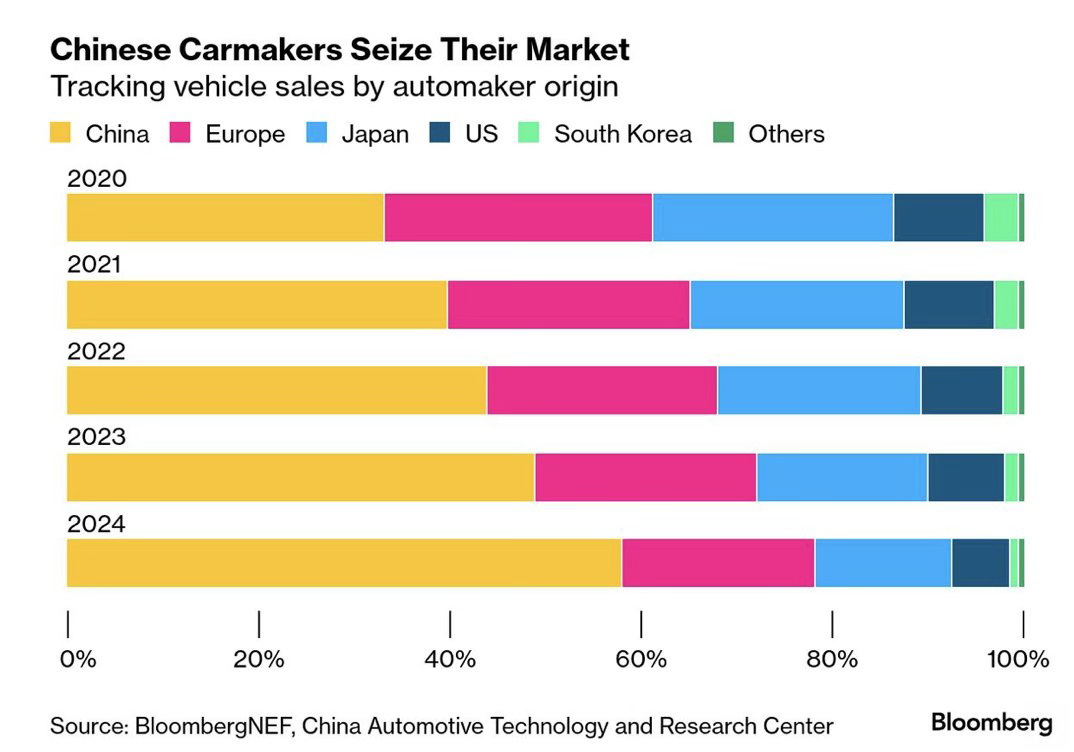


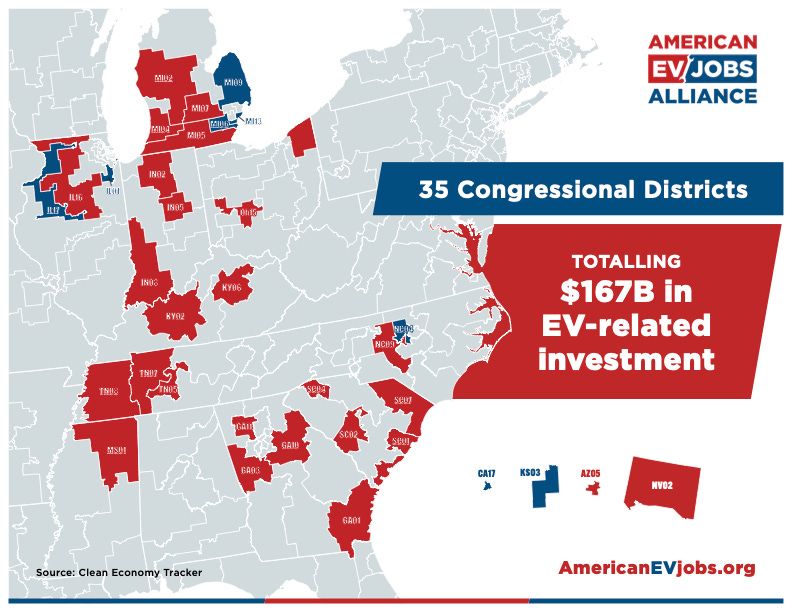
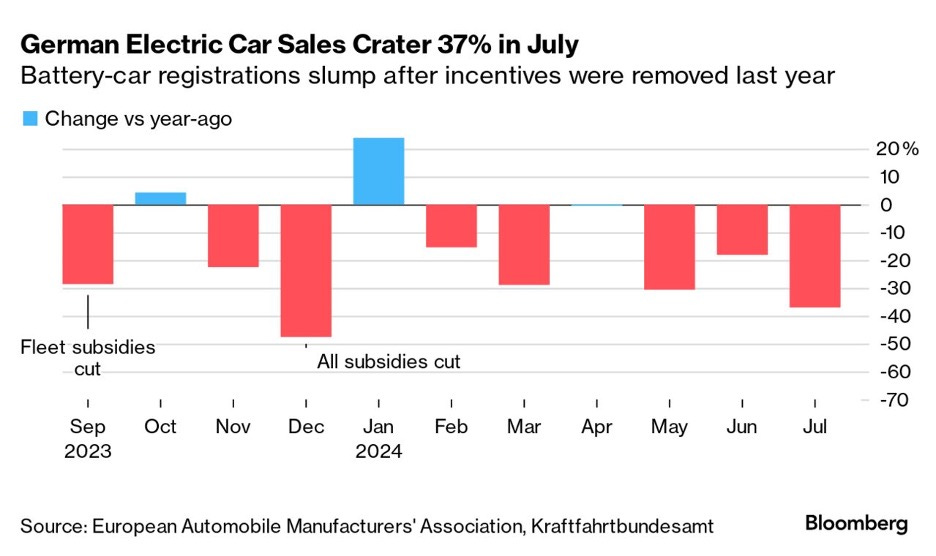
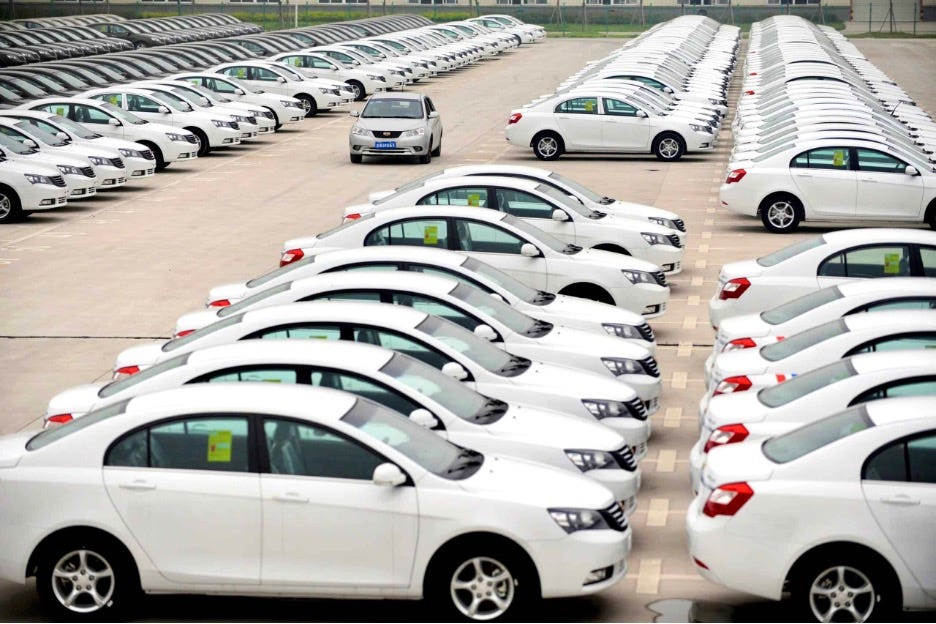
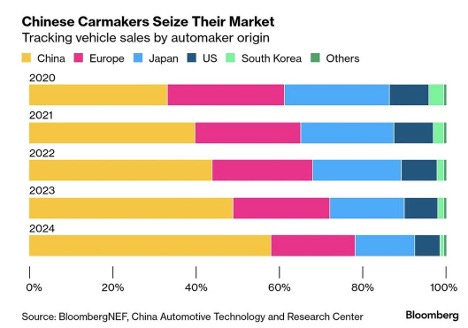
Mike - You wrote, "When Germany cut its consumer EV subsidies, sales dropped 27%." Well, there's a good historical example closer to home of what happens when incentives disappear. In 2014, The state of Georgia had a generous $5,000 tax credit for purchase of an EV. Presumably that was to attract an EV factory that Brian Kemp was actively lobbying for. That $5K on top of the $7,500 Federal tax credit applied to a lease payment on the Nissan Leaf back then didn't QUITE provide you with a free car, but... Well, that year, more EVs were sold in Georgia than anywhere else in the US except California, with a year over year increase of over 600% according to Statista. Suddenly, Rs in the state legislature woke...err umm, awakened to that fact when they realized that the vast majority of those sales were in the Dem populated metro Atlanta area. Well, they HAD to put a stop to THAT! The Rs killed the tax credit and lo and behold, within 6 months, EV sales dropped by 90% I literally had a GOP state senator tell me at the time that "we can't be giving free cars to these Democrats. Just wanted to remind y'all.
I’ve said recently that both Trump and Musk are bad at business. Trump has six bankruptcies, I’m pretty certain he squandered all the money he inherited from his father. Musk destroyed Twitter and turned it into a right wing hellscape. His cyber truck is liable to burst into flames, his rockets fall out of the sky. These are not captains of industry. If the U.S. withdrew Musk’s contracts with various government agencies it would definitely cut into his bottom line. He’s obviously pushing the limits to see how much he can get away with. He has no understanding of what various government agencies do and as a result is damaging America’s standing around the world as well as destroying those agencies. He hates USAID because it helped bring down Apartheid. He’s a racist to his core, as is Trump, son of a man who knowingly attended a KKK rally and was fined by the federal government for discriminating against Black renters in their U.S. financed buildings.
Plus both of them are not sane people. All you need to do is look at their behavior. Looney. Musk in particular exhibits clear signs of being drunk on his own concoctions and ketamine. Some people think Trump is addicted to Adderall. The thing about that idea is that many drugs, including Adderall, do not work as they were designed to do in people over 62-65. The NIH website to check medications and their side effects, Medline Plus, added a sentence to many medications several years ago cautioning people that if you are over that age range you may get no benefit from that medication. Maybe he takes it, maybe not. But I tend to find that contention dubious. He may take something else, but given his distaste for alcohol, I wonder if he would take a medication that addicted him. He is just stupid and impulsive. He does not need addiction to explain his erratic behavior.